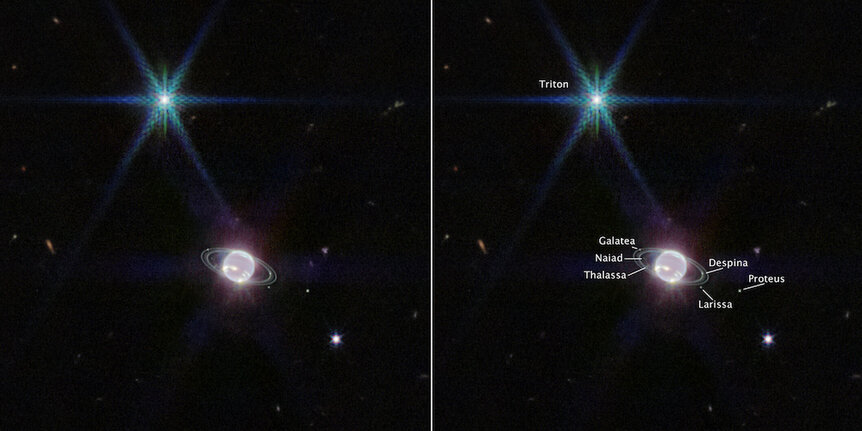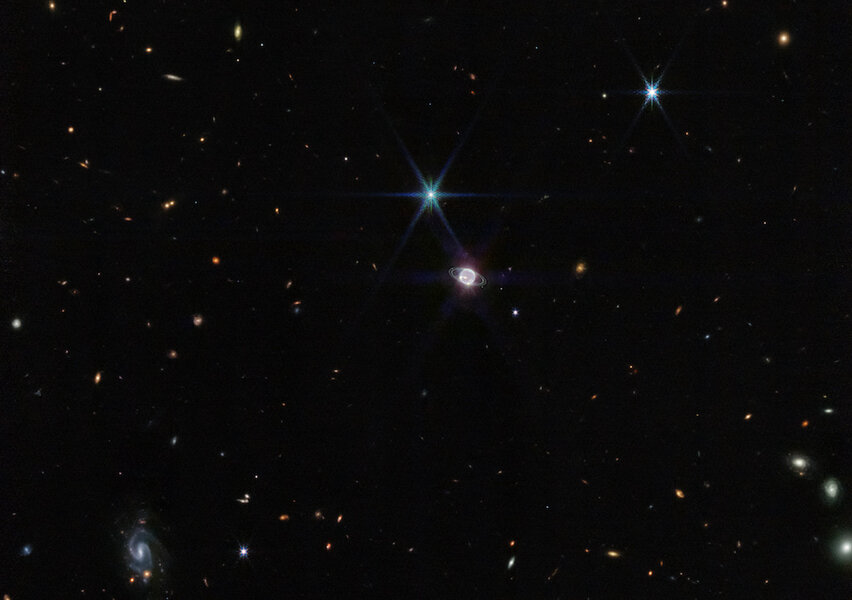JWST’s Neptune: The best infrared view in 30 years
JWST spies on Neptune and sees storms, rings, and moons.

Neptune is the keeper of the deep: The last known major planet from the Sun, the god of the boundless sea beyond the inner solar system that marks the shore of the black depths of interstellar space.
Despite being four times the diameter of Earth, its distance of a soul-chilling 4.5 billion kilometers from us makes Neptune tiny and faint even through large telescopes — which is why it wasn’t discovered until 1846.
Our only close-up view was sent back to us from Voyager 2 in 1989… but JWST just set its sight on the distant world, sending back some of the best views of its moons and rings we’ve had in three decades.
Whoa. There is a lot going on with this far-off planet.
A reminder that this shot is a combination of images taken in the near-infrared, wavelengths of light longer than the human eye can see. The physics of what we see is a little different than from visible-light images, which naturally makes this a lot more fun to investigate.
Neptune is what planetary scientists call an ice giant, because it has a lot of molecules like methane, ammonia, and water inside, which planetary scientists call “ices” even though technically they are likely a weird form of high-pressure liquid deep in the atmosphere. Methane is very good at absorbing red light, making the planet look a rich blue at the eyepiece — I’ve seen it myself and the color is quite lovely — but it also absorbs infrared light, so Neptune looks relatively faint in JWST images.
However, it has high-altitude methane ice clouds, which, unlike the gaseous form, are very reflective and appear bright. They appear at various latitudes above the deeper cloud deck, somewhat like storms on Jupiter.
Like the other three giant planets, Neptune has several rings, likely made of ice particles that are coated in various molecules that make them appear red; that makes them brighter in infrared wavelengths and obvious in the JWST image. A half-dozen small moons can be seen orbiting Neptune as well. Most are small and irregularly shaped, under 200 km wide, though Proteus is a little over 400 km in diameter. You can see some are superposed on the rings; it’s thought that Despina’s and Galatea’s gravity may help confine the nearby ring particles into narrow bands, so they’re called shepherd moons.
I’ll note my long-time friend and astronomer Heidi Hammel, an expert on Neptune, thinks another small moon, Hippocamp, can be seen, and helpfully has a labeled image with the ring names, too:
Very, very cool.
And that brilliant teal “star”? That’s actually Triton, Neptune’s largest moon. At 2,700 km wide, it’s a bit smaller than our own Moon but bigger than Pluto. It appears bright because it’s covered in frozen nitrogen which is highly reflective — the lines going through it are diffraction spikes, caused when light bends around the three legs holding JWST’s secondary mirror together with the hexagonal shape of its component mirrors. You can only get them this obvious when the light source is very small in an image, what astronomers call a point source; a bigger source like Neptune also has them but they’re smeared out and appear much fainter, making them difficult to see.
Triton is a weirdo; it orbits Neptune backward relative to the planet’s spin, which makes astronomers think it may be a large Kuiper Belt Object, captured by the planet’s gravity long ago. This is difficult to do and the exact mechanism in this case isn’t known.
This close-up shot of Neptune shows more detail of the clouds and the rings; some fainter inner rings are visible. Interestingly there’s a very narrow and faint line going around the planet right at its equator. Neptune’s atmosphere is very unlike ours, with circulation moving from the poles toward the equator, where the gases sink and warm up. This faint arc may be warmer gas glowing in infrared as it heats.
One more image, because this one is so cool:
This spectacular wide-angle view again shows Neptune and Triton, but this time almost everything else you see in the image is a background galaxy, hundreds of millions or even billions of light years away. It’s a poetic reminder that Neptune is the last big outpost of the solar system.
This is not the last word on this planet from JWST; more observations will be made over time to track the moons, rings, and storms. And on Twitter, Dr. Hammel also notes that spectra are coming as well, where we’ll be able to probe the planet’s atmospheric composition! So there’s lots more science yet to come.
As always, Stay Tuned.































